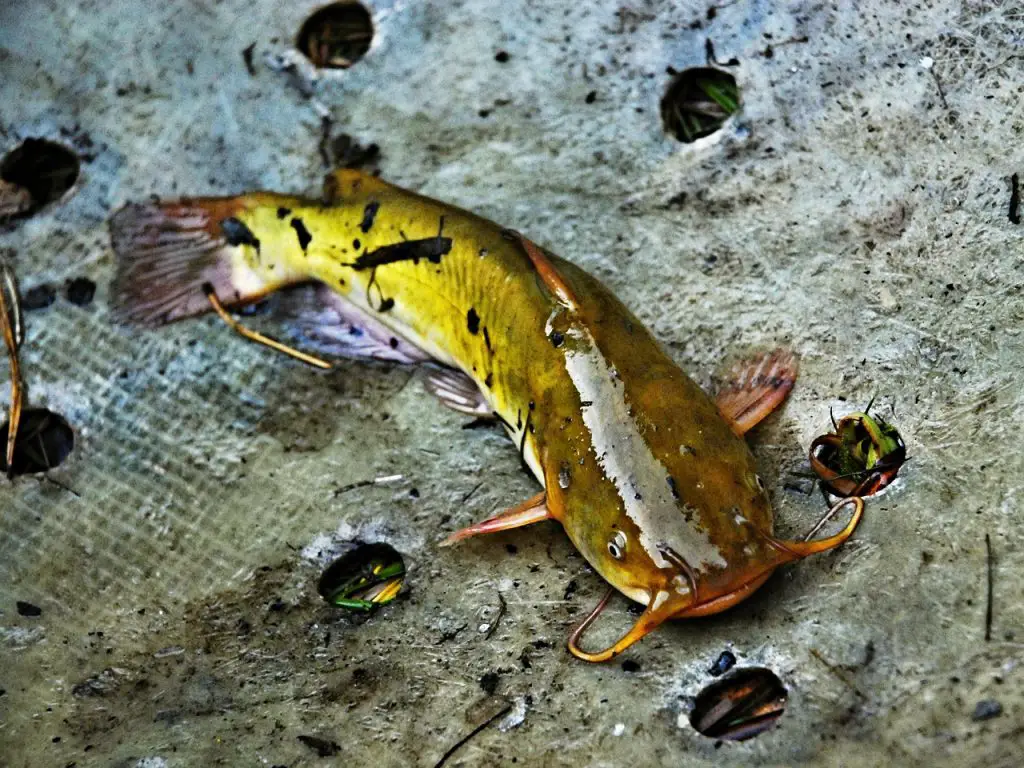Catfish are one of the most distinct fish out here because of their appearance courtesy of their whiskers, that are like those of a cat. There are several species of these fish all over the world apart from one in Antarctica. They thrive well in fresh water.
Catfish traits
-
They have no scales
The unique and evident feature of catfish is that they have no scales. There are a wide variety of catfish species but, only the electric catfish has scales. The merit of lacking scales is that they easily slip away from danger such as attacks from other predators including fishers.
-
They have barbels (Whisker-like organs)
All catfish have barbels, or the famous whiskers. The role of the barbels is to help the fish smell food from miles away even when it cannot reach the sea. The benefit of the barbels is that it substitutes the work of their poor eyesight by providing the fish with 100,000 taste buds.
-
Catfish have Flatheads
Catfish have a massive head for accommodating all the barbels and help in deep diving when scouting for food. The benefit of the flathead make up for their density and less breathing capabilities. It is the same reason they prefer diving for food than floating and hunting.
-
They are potentially poisonous
There are two major species of catfish called Plotosidae (also known as the eeltail catfish) and Heteropneustes (also known as the Airsac Catfish) that possess a potentially hazardous protein that they release when their stress levels elevate. If the poison stays in your body for far too long, it may result in untimely death. Neither of these types of catfish are native to North America.
-
Catfish can communicate
Catfish can communicate with one another using two major mechanisms, sound and smell. The role that sounds and the whole communication capability play in their lives is to help different families warn others about impending or incoming dangers like attacks from natural predators in fresh waters. Their swim bladder helps them to amplify sounds when communicating.
-
Catfish can walk for short distances
Catfish have the unique ability of movement across short distances. Unique types of catfish like the Asian can use part of their fins and head to walk for a short distance. Research proves that the reason why they can walk on land is that they have mucus on their slippery skin rather than possess scales like other fish.

Habitats
-
Freshwater
Most catfish if not all like to live in fresh waters. A quick delve into the history of their origin will be fast to reveal the fact that over one century ago, the first catfish was found in Britain, later Italy and the rest of the world.
Size
These fish can grow up to a maximum of 2 meters, or bigger than 6 feet. Most catfish that grow in ponds have a higher chance of growing bigger and better as opposed to those living out in the wild because ponds lack natural predators, unlike wild waters.
Spawning Traits
Catfish can spawn and the best time to do so is around the beginning of summer when the degree of water has risen to 76 degrees. The reason they choose to lay eggs during this season is that the eggs need a constant heat supply for safe hatching. The Blue Catfish can build a nest and keep their young ones safe at all costs. On the average, a typical female catfish can lay up to 20,000 eggs all of which will hatch within a maximum of ten weeks. As soon as they hatch, all males must guard and protect the fry from all possible dangers for the safety and health of the newly born.
Diet and Feeding
Different kinds of catfish can feed at contrasting times according to their genetic make-up. They can feed during the day and at night, because rather than eyesight, they rely solely on the sense of smell. They eat small foods like tiny aquatic animals and mollusks. The fact that they can grow up to 2 meters is enough to create the impression that the big ones can feed on other smaller fish that are less threatening to their existence. they can eat both animals and vegetation depending on the species.
Types of Catfish
There are several categories of catfish but three are most common. The blue catfish is the first one. You can tell from its color which turns to black at certain times. The second one is the channel catfish. One can be able to tell from its dark brown color and slight spots. The final one is the Flathead catfish. It is brown and has no forks in its tail, unlike its two cousins.
Facts about catfish
- A good number of catfish can breathe through the skin, and it explains why most of them, apart from the electric catfish, have bodies covered in mucus
- The most amazing thing about keeping catfish in ponds is that they help in keeping it clean by eating away all contaminants
Importance of catfish
They are low on mercury
Catfish live in freshwater sources. It creates the impression that it has low mercury levels.
Catfish are a source of Proteins
Catfish are rich in protein that helps in building muscles.
They have Vitamin B-12.
Catfish offers both protein and vitamins which help you develop great eye sights and resist all types of infections.











Pingback: Are Catfish Poisonous, Dangerous and Invasive? | Reel Fishing Guru
Pingback: Are Catfish Cold or Warm-blooded? | Reel Fishing Guru
Pingback: How do catfish use their whiskers? | Reel Fishing Guru
Pingback: 5 Best Catfish Rods Review and Buying Guide | Reel Fishing Guru
Pingback: Are Catfish Cold or Warm-blooded? | Reel Fishing Guru
Pingback: Are Catfish Poisonous or Dangerous? | Reel Fishing Guru
Pingback: How To Fish For Catfish | Reel Fishing Guru
Pingback: 4 Best Catfish Rods Review and Buying Guide | Reel Fishing Guru
Pingback: How much do catfish grow per year? | Reel Fishing Guru
Pingback: How do Catfish Communicate? | Reel Fishing Guru
Pingback: Are Catfish Attracted to Blood? | Reel Fishing Guru
Pingback: How do Catfish Mate? | Reel Fishing Guru
Pingback: How Do Catfish Survive in Mud? | Reel Fishing Guru
Pingback: What are Catfish Teeth, and More to Know | Reel Fishing Guru
Pingback: Do Catfish Sleep and Why Would they Sleep? | Reel Fishing Guru
Pingback: How Far do Catfish Travel in a Day? | Reel Fishing Guru
Pingback: Is Catfish Good for You? | Reel Fishing Guru
Pingback: Difference Between a Catfish and Cod | Reel Fishing Guru
Pingback: How Long Would It Take a Catfish to Completely Breakdown After It Dies? | Reel Fishing Guru
Pingback: Why do Catfish Smell Bad? | Reel Fishing Guru
Pingback: Does Holding a Catfish by the Gills Hurt it? | Reel Fishing Guru
Pingback: What Is a Catfish Algae Eater? | Reel Fishing Guru
Pingback: How Are Catfish Farmed? | Reel Fishing Guru
Pingback: Do Catfish Like to Swim Around People? | Reel Fishing Guru
Pingback: Should you have Slack in your Line When Fishing for Catfish? | Reel Fishing Guru
Pingback: What is the Difference between Catfish and Bluegill? | Reel Fishing Guru
Pingback: What is the Difference Between a Catfish and Skate? Explained Simply | Reel Fishing Guru